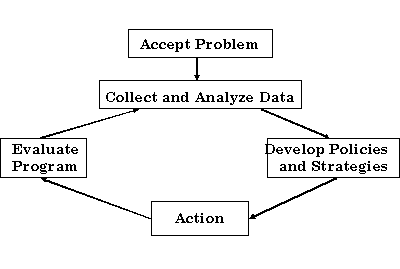Planning Analysis:
Housing Needs Assessment
The affordable housing
situation in the United States is serious. Communities and social service agencies are
experiencing increasing difficulty in providing housing for low-income households. For
example, in 1993, the number of low-rent units fell to 6.5 million, while the number of
low-income renters rose to 11.2 million resulting in a shortage of 4.7 million units. In
addition, between 1973 and 1993, the median income of renters dropped 19 percent, while
the average rent increased 12 percent.
In 1996, an adult working full-time at minimum wage earned about
$823 a month before taxes. The average market-rate rent in the United States is $428 for a
one-bedroom apartment. According to a recent study by the U.S. Department of Housing and
Urban Development, 5.3 million households spend more than half their income on rent
or are living in seriously substandard housing.
Affordable housing is not just a national problem. Oregon faces many
of the same difficulties as other regions of the Country. Oregon's 1992 Comprehensive
Housing Affordability Strategy (chas) indicated that 56,000 Oregon households (about 4
percent) are currently paying more than 30 percent of their income on housing. An
estimated 20,000 homeless persons in Oregon also need housing and other assistance. While
the number of housing units considered affordable is declining, the number of households
in poverty is increasing.
These trends are the result of changes in the traditional economic
base of communities, population increases, changes in the number of units in the housing
stock, and the rising costs of new construction.
In 1993, the Oregon Department of Housing and Community Services
published a document called the Housing Strategies Workbook. The Workbook provides
a framework for conducting a community housing needs assessment. The following information
provides a brief summary of the model described in the Workbook.
Housing Needs Assessment Model

The key steps in the model:
Housing Need and Buildable Lands Inventory
- Household projections for 20-year planning period
- Housing Stock inventory
- Needed housing units (estimated) for planning period
- Buildable land inventory
- Availability of sufficient buildable land
- Current Housing Stock Condition
- Crowding
- Citizens Needing Assistance to Obtain Safe, Decent Housing
- Low, Very Low, and Severely Low Income Households
Persons with special housing requirements
Major Issues Addressed in a Housing Needs Assessment
Has the community developed an adequate strategy to
house its citizens for a 20-year planning period?
- Is the community’s current housing stock in good condition or in
need of rehabilitation?
- What citizens will need financial assistance or social services to
obtain affordable, safe, decent housing?
- What citizens have special housing requirements?
- Will other data and analysis be useful for affordable housing
activities?
Has the community developed an adequate
strategy to house its citizens for a 20-year planning period?
How many households do you expect for the 20-year
planning period?
- What is the existing housing supply?
- How many housing units are required to accommodate the expected
households during the 20-year planning period? How many of each residential structure type
(e.g., single family, multi-family, etc.) are required?
- How many acres in the UGB are buildable?
- Does the community have enough land to accommodate the projected
households?
Is the community’s current housing
stock in good condition or in need of rehabilitation?
Types of condition data (from assessor/census)
Is crowding a problem?
A unit is typically considered
"overcrowded" when the number of residents exceeds one person per room
- The definition does not include spaces such as hallways, foyers,
storage rooms, bathrooms, closets, and laundries.
What citizens will need financial assistance or social services
to obtain affordable, safe, decent, housing?
Poverty Level: The federal poverty level is one
measurement useful determining income standards and housing affordability.
- Low and Very-Low Income: The HUD standards define households as
"low income" if total household income is 80 percent or less of the median
income of the area, and as "very low income" if household income is 50 percent
or less of the median. This method presents a significant limitation, however, by not
considering household size.
- Cost Burden: The total amount a household spends on housing is
referred to as cost burden. Total housing expenses are generally defined to include
payments and interest or rent, utilities, and taxes. HUD guidelines indicate that
households paying more than 30 percent of their income on housing experience "cost
burden," and households paying more than 50 percent of their income on housing
experience "severe cost burden."
What citizens have special housing
requirements?
At risk youth, homeless and/or runaway
- Farm workers, seasonal/migrants
- Homeless and at-risk homeless
- Persons released/about to be released from correctional institutions
- Persons with physical disabilities
- Persons with psychiatric disabilities
- Victims of domestic violence
Will other data and analysis be useful for affordable housing
activities?
More detailed local market analysis
- Detailed land inventories
- Interview social agency representatives
Community Planning Workshop has completed a number of
housing needs assessments in Oregon. The most recent project was for Josephine County.
[Home | Syllabus | Schedule
| Assignments | Project
| Links]
This page maintained by Bob Parker,
©2002
October 21, 2003

